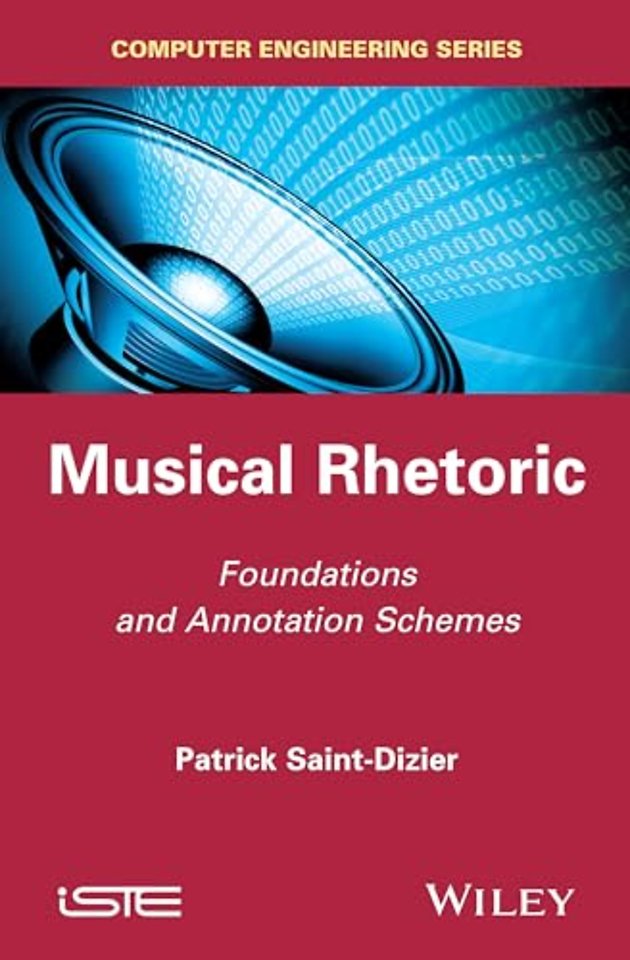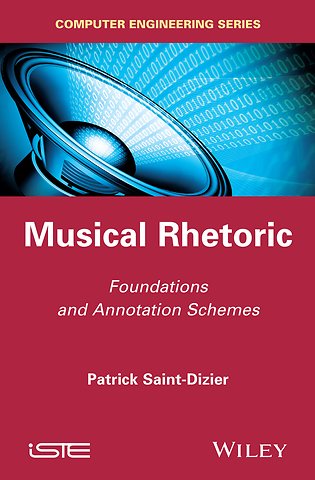Musical Rhetoric – Foundations and Annotation Schemes
Foundations and Annotation Schemes
Specificaties
Inhoudsopgave
<p>CHAPTER 1. AN INTRODUCTION TO CLASSICAL RHETORIC 1 </p>
<p>1.1. A few basic definitions 2</p>
<p>1.2. The structure of rhetoric 4 </p>
<p>1.2.1. Rhetoric and communication 5 </p>
<p>1.2.2. The structure of classical rhetoric 6</p>
<p>1.2.3. The invention step 7</p>
<p>1.2.4. The arrangement 9</p>
<p>1.2.5. The style or elocution step 12</p>
<p>1.2.6. The delivery or action 14</p>
<p>1.2.7. The facets of rhetoric 15</p>
<p>1.3. Some figures of speech 17</p>
<p>1.3.1. Introduction 17</p>
<p>1.3.2. The major figures of speech of interest in music rhetoric 18</p>
<p>1.4. Argumentation and explanation 21</p>
<p>1.5. Conclusion: a few historical milestones of traditional rhetoric 25</p>
<p>1.6. A few historical references for classical rhetoric 28</p>
<p>CHAPTER 2. LANGUAGE, MUSIC AND THE RHETORIC DISCOURSE 31</p>
<p>2.1. Music and language 31</p>
<p>2.1.1. On the relations between language and music 32</p>
<p>2.1.2. Going into the details of music parameters, music for rhetoric 36</p>
<p>2.1.3. Music and rhetoric 42</p>
<p>2.2. A few historical milestones of music rhetoric emergence and evolution 43</p>
<p>2.2.1. The Middle Ages and the Renaissance 44</p>
<p>2.2.2. The transition between the Renaissance and the Baroque period 48</p>
<p>2.2.3. The Baroque period 51</p>
<p>2.2.4. The Classical period 54</p>
<p>2.2.5. The Romantic period 56</p>
<p>2.3. Main contemporary trends in music rhetoric 58</p>
<p>CHAPTER 3. THE SYMBOLISM OF MUSICAL ELEMENTS 61</p>
<p>3.1. Symbolic and perceptual properties of modes and tonalities 62</p>
<p>3.2. Perceptual and symbolic properties of intervals 65</p>
<p>3.3. Musical figures and their role in rhetoric 67</p>
<p>3.4. Figures of rhythm and their roles in rhetoric 74</p>
<p>3.5. Motive alternations 79</p>
<p>3.6. Figures of counterpoint 80</p>
<p>3.7. The symbolism of numbers and proportions 83</p>
<p>3.8. The rhetoric contents of classical forms 87</p>
<p>3.8.1. The perception of large forms 87</p>
<p>3.8.2. The simple bi– and tripartite forms 88</p>
<p>3.8.3. The sonata forms 95</p>
<p>3.9. Conclusion 98</p>
<p>CHAPTER 4. FEATURE STRUCTURES FOR REPRESENTING MUSICAL CONSTRUCTIONS 101</p>
<p>4.1. Feature structures in language 102</p>
<p>4.2. Representation of a melody by a feature structure 104</p>
<p>4.3. From musical motives to polyphony 109</p>
<p>4.4. Dealing with harmony 110</p>
<p>4.5. A few generic operations of feature structures 112</p>
<p>4.5.1. Transformations by augmentation or diminution 112</p>
<p>4.5.2. Mirror forms 114</p>
<p>4.5.3. Reverse forms 116</p>
<p>4.5.4. A few other transformations 117</p>
<p>4.5.5. Expressive power of this formalism 117</p>
<p>4.6. Elements of annotation of musical structures in XML 118</p>
<p>4.6.1. Basic feature structures 118</p>
<p>4.6.2. Advanced XML annotations for two–dimension structures 120</p>
<p>4.6.3. Figures of sound in XML 121</p>
<p>4.7. Perspectives 125</p>
<p>CHAPTER 5. A RHETORIC ANALYSIS OF MUSICAL WORKS 127</p>
<p>5.1. Discourse theories in linguistics 128</p>
<p>5.1.1. The rhetorical structure theory 129</p>
<p>5.1.2. The pragma–dialectic movement 131</p>
<p>5.2. The rhetoric of the stylus phantasticus 132</p>
<p>5.3. The rhetoric and argumentation dimensions of J.S. Bach s C. minor Passacaglia 140</p>
<p>5.3.1. The global structure and the symbolic of numbers 140</p>
<p>5.3.2. The structure of the argumentation in the Passacaglia 142</p>
<p>5.4. The dialectics of the personality split 147</p>
<p>5.5. Beethoven s Muss es sein? Question and debate 149</p>
<p>5.5.1. The personal context 149</p>
<p>5.5.2. The questions and their formulations 150</p>
<p>5.5.3. The response formulations 155</p>
<p>5.6. A high–level notation for the structure of musical works 161</p>
<p>5.7. Conclusion 166</p>
<p>BIBLIOGRAPHY 167</p>
<p>INDEX 177</p>

